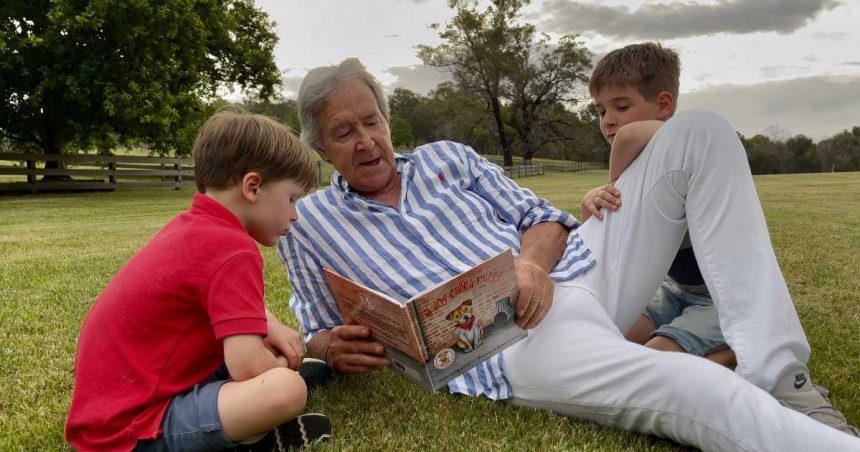After four decades as a father, grandfather and beloved children’s author, PRG Collins shares his wisdom on teaching kids the important lessons they will need later in life.
As any teacher will tell you, kids are forced to grow up a lot in their first few years in the schoolyard. From dealing with lunchtime games and negotiating friendship dynamics to in-class learning, students rely on what they’ve learned from trusted adults to tackle new challenges they face every day and forge their own path into adulthood.
But how do teachers go from teaching eight-year-olds their multiplication tables to helping them absorb the right life lessons they will carry with them long after leaving your classroom?
Children’s author PRG Collins hopes to help bridge that gap with his latest entries into the popular Life Lessons for Kids series. Similar to popular children’s shows like Bluey, the books see cartoonish animals like Freddy the Frog and LJ the Kangaroo navigate real-world social situations and teach kids how to approach difficult life choices they will, inevitably, encounter.

Based on stories he told his own children, Collins says he hopes to spark students’ interest in big life questions in a way that they can understand.
“These stories are dedicated to my children Lachlan, Candice, Tyson, and Murdoch. They listened to the stories at night when they were little children living on our farm near Melbourne,” he told EducationDaily..
“As parents, we have loved and guided our children in their early years. We will always remember this wonderful and unique experience with pride and pleasure.
“If the lessons they learned – or the ‘Life Lessons for Kids’ – can now bring safety, security, and sensibility to your children, our family will have succeeded in passing along an important baton.”
With the Life Lessons series proving to be a smash hit amongst parents and teachers alike, Collins shares some of his top tips for teaching young children important lessons that will help set them up for life.
Timing – Choose the right moment
Like in comedy, timing is everything when talking life lessons. Collins says that it’s vital parents and teachers pick the perfect moment to bring up serious topics or run the risk of the advice falling on deaf ears.
“Kids four – eight-years-old typically concentrate and listen when they are in a quiet environment, like classroom reading time or pre-bedtime in their room,” he told EducationDaily.
“This is the ideal time to approach an important conversation; with minimal distraction, there’s a better chance they will listen and absorb what’s being shared.”
Introduce the subject clearly
If you’ve ever sat with a child for more than 10 minutes, you know they’re full to the brim with questions. Many blurt out anything, anytime – and to anyone – as they try to understand ‘why is the sky blue?”, or the always fun “Where do babies come from?”.
But Collins says educators can use this to their advantage by prompting children to ask the right questions that get the ball rolling in talking about life lessons.
“Questioning in a quiet moment can open a discussion such as: ‘Do you ever wonder why so many fires start? Let me tell you about a Snake called Sammy’, Collins says.
“Or: “All kids your age have to go to the dentist sometime, but imagine if you hardly had to have anything done? Let me tell you about a Horse called Honey.”
“Or: ‘Today we’re going to read about how learning to swim can save someone’s life…or even your own. It’s a story about a dog called Ruffy’.”
“This primes the children to listen, capturing their attention on what’s about to be shared. Kids love storytelling – it’s much more engaging and memorable – so if you can talk about a topic through a story or example, they’re more likely to listen carefully and remember.”
Spark curiosity, not fear
Big topics bring with them their own scary challenges. I still remember breaking down into existential dread as a young child when, after a classmate’s funeral, I discovered that everyone would one day die (still not a great thought).
However, Collins says it was important that conversations about these scary subjects prompt ways of thinking rather than promote confronting situations.
“The aim of these conversations is not to scare children when talking about possibly scary subjects,” he says.
“It is rather to lead their thinking to: “What would I do in a situation that will most likely come up in my life over the next five – 15 years to enable me to stay safer, to give me the correct ‘gut’ feel about something, to prompt me to be able to quickly assess a danger, to be better able to keep myself healthy and happy!”
“Life Lessons for Kids books can be used as a tool to talk about a range of topics, challenges and situations in a way that’s gentle, enjoyable and nurturing.”







